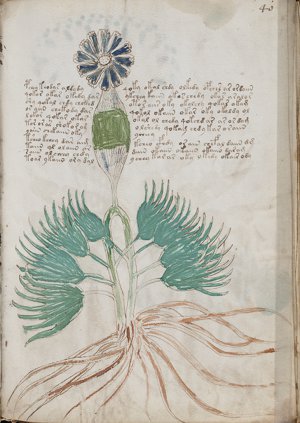

“Balneological pages” or “biological section” (nymphs, baths, plumbing, folios 75r-84v) “Astronomical pages” (other circular designs, folios 67rl-70r2, etc.) “Astrological pages”(circular volvelles with nymphs, folios 70v2-73v) “Pharma pages” or a “pharmaceutical section” (pages with multiple plants and apothecary jars, sometimes termed “maiolica”) “Herbal pages” or a “botanical section” (pages with a single type of plant) By convention of Voynich researchers, the manuscript includes the following: The pages are in pairs (“folios”), ordered with the number on the facing page on the right as recto, the reverse unnumbered on the left as verso (thus folios 1r, 1v, 2r, 2v, etc. is numbered with Arabic numerals in an ink and penmanship different from the work’s text portions.

is compatible with a real language sequence. Recently, however, Marcelo Montemurro, PhD, and Damián Zanette, PhD, researchers at the University of Manchester and Centro Atómico Bariloche e Instituto Balseiro, have used information theory to prove that the Voynich Ms. These theories with no solid evidence have clouded the whole field of study, and many scholars consider research into the Voynich Ms. Of course, aliens also have been implicated in the most bizarre theories. As such, almost every language, from Welsh to Chinese, has been suspected of being hidden in the text. was discovered in Italy - that this is a European manuscript, but some also have proposed Asian and North American origins. As Zandbergen relates, past researchers primarily have proposed - because the Voynich Ms. Information is continually updated on the website of René Zandbergen, 7 a long-term researcher of the Voynich Ms., and, along with Gabriel Landini, PhD, one of the developers of the European Voynich Alphabet (EVA) used to transcribe the strange alphabet or syllabary in the Voynich Ms. 1-5 However, what appears to be a reasonably reliable introduction for the novice is provided at Wikipedia. With such voluminous published information, its history can be easily found elsewhere and need not be repeated here ad nauseum. Even the US National Security Agency has taken an interest in its cryptic contents, and doctoral theses have been written on attempts to decipher the language of the Voynich Manuscript (hereinafter abbreviated Ms.). Since 1912, this manuscript has elicited enormous interest, resulting in books and Internet sites with no sound resolution on the manuscript’s origin. This manuscript, written in an obscure language or, perhaps, code, is now housed at the Beinecke Rare Book and Manuscript Library at Yale University, 1 which acquired it in 1969. Voynich, a Polish-born book collector living in London, discovered a curious manuscript in Italy.
#Wiki voynich manuscript pdf
In addition you can view a PDF of the article here. Please refer to the printed or pageflip versions of HerbalGram. Due to limitations in the online HTML coding these are not present. ONLINE NOTE: There are numerous usages of the Voynich Typeface/Font throughout this feature.


 0 kommentar(er)
0 kommentar(er)
